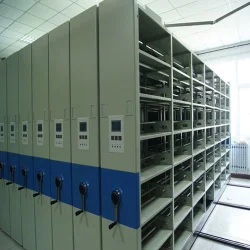Here are key features and aspects of mobile shelving
2023-12-12
Mobile shelving, also known as mobile storage or high-density mobile shelving, refers to a storage solution that maximizes space efficiency by reducing the number of fixed aisles between shelves. Instead of having multiple static aisles, mobile shelving systems use movable shelving units that can be compacted or expanded as needed. These systems are commonly used in various settings, including offices, libraries, archives, and warehouses. Here are key features and aspects of mobile shelving:
1. Mechanical or Electric Systems:
- Mobile shelving systems can be operated manually, using a mechanical assist, or they can be powered by electric motors for automated movement. Electric systems are often more convenient, especially for larger installations.
2. Compactable Design:
- The primary feature of mobile shelving is its ability to compact or move the shelving units horizontally along tracks. When not in use, the system can be compacted to create a single accessible aisle. This design optimizes space utilization.
3. Tracks and Carriages:
- Mobile shelving units are mounted on tracks or carriages embedded in the floor. The tracks guide the movement of the units, allowing them to be easily repositioned.
4. Manual Handwheels or Controls:
- In manual systems, users typically use handwheels or handles to move the shelving units along the tracks. For electric systems, controls such as buttons or touchpads are used to operate the system.
5. Safety Features:
- Mobile shelving systems are equipped with safety features to prevent accidents. These may include sensors that detect obstructions, emergency stop buttons, and warning signals.
6. High-Density Storage:
- By eliminating unnecessary aisles, mobile shelving systems provide high-density storage. This is particularly beneficial in environments where space is limited, and maximizing storage capacity is crucial.
7. Customizable Configurations:
- Mobile shelving systems are often customizable to fit specific storage needs. Shelving units can be designed with various configurations, including adjustable shelves, pull-out reference shelves, and dividers.
8. Applications:
- Mobile shelving is used in a variety of settings, including offices, libraries, archives, museums, warehouses, and healthcare facilities. It is especially useful in spaces where storage requirements are high, and available floor space is limited.
9. Archival and File Storage:
- In archives and offices, mobile shelving is commonly used for storing files, documents, and records. The high-density storage allows for efficient organization and retrieval of materials.
10. Library Storage:
- Libraries often use mobile shelving for book storage. The compactable design allows libraries to maximize their book storage capacity while still providing convenient access.
11. Warehouse Storage:
- In warehouses, mobile shelving can be used for storing various items, including inventory, parts, and supplies. The high-density storage maximizes warehouse space utilization.
12. Ease of Access:
- Despite the compactable design, mobile shelving systems are designed for ease of access. Users can easily move the shelving units to create an accessible aisle and retrieve items.
13. Installation and Maintenance:
- Installation of mobile shelving systems may involve embedding tracks into the floor, and maintenance typically includes routine checks of mechanical or electrical components.
Mobile shelving is a versatile storage solution that helps organizations optimize their available space while providing efficient and organized access to stored items. The choice between manual and electric systems depends on factors such as the size of the installation and the user's preferences for convenience.



